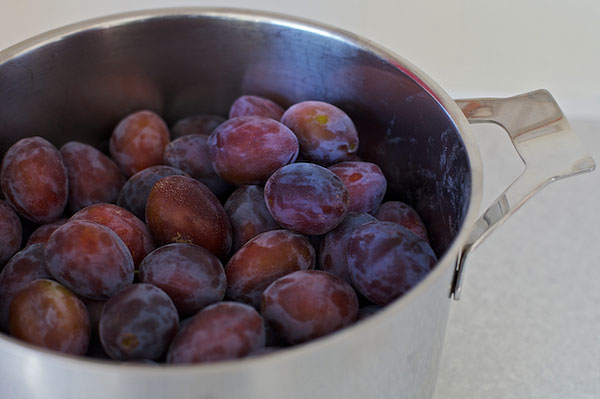
Our damson tree has never been so laden with powdery blue fruits and this year they’ve clumped together like bunches of giant, velvety grapes. Clusters and clusters of them all over the tree. I’m planning to make spiced damson chutney and damson gin but these are barely enough to make dent and so this year there has been jam too – a caramelised boozy jam of damsons and port.
Fingers crossed, this is our last year in our current house (probably, you know how these house moves go – nothing is certain until you get the keys). This also means that it is our last year in our current garden and so I’m especially determined to make good use of our plum, damson and apple trees. I’m a big fan of using freezer compotes as a low sugar way to preserve fruit, but with three fruit trees and one small freezer I’ve had to branch out.
Jam needs its high sugar content to make sure that the jam sets properly and doesn’t spoil and go mouldy in the jar. Theoretically you can use a little less sugar in damson jam compared with other fruit jams because of the damson’s high pectin content (it should set at a lower concentration), but we’re not talking about eating half the jar as one of your ‘five a day’ here so to my mind what’s more important is a successful afternoon in the kitchen. Damsons (and plums) are a great place to start out in jam making by the way because of the aforementioned high pectin content – they’re more than likely to set unlike some fussier preserves like strawberry.
My jam is a chunky full fruit preserve which contains the fruit skin but I have also made a batch of a smoother, jelly-esque damson jam. If you’d like to try the smooth variety you can remove the fruit skin and the stones together in one clever step, bypassing the need to stone the damsons by hand. Boil the fruit and water as per my recipe but before you add the sugar press the fruit through a metal colander, thus retaining the stones and any big bits of fruit. This bit of kitchen genius comes strangely from unruly haired Mayor of London, Boris Johnson who is also quite right in his promotion of jam making as a unisex activity. “If women can go to work and suffer the curse of ambition, then we men are entitled to the restful consolations of jam-making”.
The damsons go through a riot of colours before settling at a deep, rich burgundy that is nothing like the yellow of the fruit’s flesh or the blue outer. Having made the jam the boy and I were impatient to try it out the next morning but the end slices of our supermarket granary just didn’t seem proper and so we whisked up a batch of Heidi Swanson’s Easy Little Bread Recipe from 101 Cookbooks. Its short, dense slices would be hopeless for making a sandwich but this slightly sweet, oaten bread was probably designed with homemade jam and a smudge of butter in mind. And as the title suggests the recipe is really very easy.
Recipe for Damson and Port Jam
For jam troubleshooting and reassurance, check out Delia’s Ten steps to jam-making. I use the plate method she describes for checking for a set but you can also use a thermometer. You’ll also need to sterilise some jars (this quantity made 6 standard jam jars for me).
1500g damsons(after washing and destining)
1200g golden caster sugar
200ml water
75ml port, added at the end
Wash the damsons. Quarter each damson and chop out the stone (nobody wants jam that they have to spit out). If you chop each fruit lengthways quickly and without too much prevarication your knife will slide easily down the side of the stone and from there it is easy quarter the fruits and remove the stone.
Put 3 small plates into your freezer ready for testing if the jam is set and start to sterilize your jam jars.
Put the fruit into the pan with 200ml water and simmer for thirty minutes, giving it the occasional stir to ensure even cooking.
Allow the fruit to cool a little. Once the fruit is no longer bubbling, add the sugar and return to a medium heat. After about 10 minutes, check to see if the sugar has dissolved by stirring the jam with a wooden spoon and checking for sugar crystals on the back of the spoon. If you see any crystals, heat for a little longer until there is no sign of the sugar.
Turn the heat up to a rolling boil (a proper spluttering inferno). Once boiling, set your timer for fifteen minutes and move anything valuable out of reach of volcanic purple splatters.
After fifteen minutes have passed, it's time to start testing to see if your jam is ready to set. Get your cold plate from the freezer and pour onto it a teaspoon of jam. Put the plate into the fridge for a few minutes to cool. Retrieve the plate from the fridge and push the end of a teaspoon along the plate and through the jam. If the jam is "set" there will be a slight skin and wrinkle on the surface of the jam as you do this. If the jam doesn't wrinkle but refills the channel made by the end of the spoon keep boiling the jam for another five minutes and test again until set. It’s very variable depending on how hot you get the jam and the composition of the fruit so don’t worry if it takes longer.
Take the jam off the heat and leave to cool for 15 minutes. Now is also the time to stir in the port. If there is any scum on the top of the jam you can remove this by stirring in a small knob of butter.
After 15 minutes ladle the jam into sterilised jars and leave to cool. Label once fully cooled.



 Come join me on Twitter
Come join me on Twitter Sophie Roberts is a registered dietitian based in Oxford, UK. She loves combining her nutrition know-how with a sustainable approach to buying and preparing food and shares her tips and recipes here at Mostly Eating.
Sophie Roberts is a registered dietitian based in Oxford, UK. She loves combining her nutrition know-how with a sustainable approach to buying and preparing food and shares her tips and recipes here at Mostly Eating. 
{ 20 comments }
Your chunks of bread with butter and jam look absolutely perfect. I am a big fan of jam making. I enjoy the old-school unhurried-ness of the process and the idea that you’re making good use of a glut of fruit. Plus there’s something enormously satisfying about having your own jam lined up in the cupboard, or as they are in our case, on top of the cupboard.
I’d definitely recommend the bread recipe Kathryn. Very simple and perfect for a jam maker.
There’s nothing like having a kitchen full of your own jam is there? I must use your tip of putting them on top of the cupboard as they’re spreading all over the worktop at the moment and the cupboards are full.
Oh Sophie that looks so tasty! And wow, the damson tree is beautiful. What a colour!
I made rhubarb and vanilla jam yesterday with home grown rhubarb and just cannot stop staring at the little jars… so proud ;)
Agreed – that is indeed the best part of jam making, being able to say “I made this!” to anybody who happens to pass by :-) My jam has been on the countertop for over a week now so I’m just starting to be able to pass it without stopping to count the jars.
Rhubarb and vanilla jam sounds delicious by the way. I do like a bit of rhubarb and ginger but vanilla sounds a bit more mellow
those damsons are so gorgeous – how wonderful to have them in your yard – I love Boris Johnson’s jam wisdom too – though I am not sure that women get the best end of the swap!
I will miss the damson tree the most when we move – they’re such an glorious colour. I might have to plant a tree in our new garden
Beautiful fruit on the tree & gorgeous preserves in the jar! And a perfect post to usher in the changing of the seasons. I equate plum preserves and almost-autumn, or do now, as last year my mom and I made some jam from the orphan prune plum tree near her home.
Your recipe sounds delicious & your writing, delightful, as usual. I smiled at Boris Johnson’s opinion but don’t disagree with it — I’m craving some kitchen consolation myself not that I’m particularly ambitious in the workplace ;-).
So how many jars do you and the boy go through in a week/month?
Yes, it’s a proper autumn thing plum and damson jam. I can’t decide if I’m happy or horrified about the encroaching cold weather.
We’re not getting through the jam too quickly – we’re about half way through jar one of about eight jars, after a fortnight. I might need to enlist some help!
Oh I always leave mine sitting on the kitchen bench or dining room table for a few days – to smile, count and tell anyone who comes by that I made it. But then, yes they go up on top of the cupboard.
I’ve been thinking a lot about how much jam we eat, mainly because people keep on asking me about our jam “habit”. I reckon we go through about a jar a fortnight . . .
And at the moment there are 25 jars in the kitchen . . .
25 jars is a good supply of jam!
You and Elaine have prompted me to think about how quickly we get through our jam. It’s probably about a jar in three weeks, mainly on porridge. Marmalade is much less resistible to me and goes quicker.
It’s definitely addictive having all of those jars lined up. I think we should start a jam-making campaign as a source of contentment and mental wellbeing!
That looks incredible and I’ve been meaning to make that bread so thanks for the reminder!
I made my first plum jam yesterday using a recipe from the River Cottage Preserves book and the little jars sitting on the worktop are making me so happy. Blackberry next…
Hi Gemma
I highly recommend the easy bread to anybody with a clutch of homemade jam to enjoy.
Plum jam is lovely but it’s nice to have a tart flavoured jam like blackberry too. Think how happy you’ll be with too lots of jam on the worktop!
The photos alone makes me want to lick the screen of my computer.
Looks Nice & Interesting. I have never tried this jam before. But will try my hand at this. Thanks for sharing your Recipe. Cheers !!
This was my first time making jam…. it is rock solid! I have a dark mess of purple stuff that is completely solid! If you lick the solid it tastes kind of nice – but it is no way spreadable! : (
Absalutely Fabulous!!!!
Super easy recipe. However, I can’t stress enough the importance of making sure the sugar is completely dissolved before embarking on the rapid boil. (You did stress this, but I didn’t pay enough heed!) I have sticky, burnt caramely damson and port jam – a real damson in distress. Considering I spent 2 hours de-stoning the blighters I was non too pleased with myself. Completely my own fault, and I will be trying again with the next batch.
Thanks for the recipe I really like the sound of the jam. Will let you know how good it has turned out.
I want to make this jam and have never used damson plums before. Do you wait until the damsons are very soft and ripe, or cook them when they are still firm? I have some now. The plums that are still firm are VERY tart.
Thanks
Delicious jam with that something extra and easy to make!